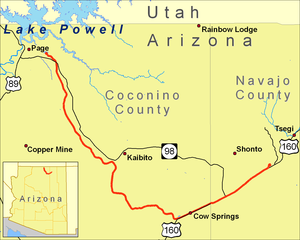Black Mesa and Lake Powell Railroad
This article includes a list of general references, but it lacks sufficient corresponding inline citations. (August 2016) |
The Black Mesa and Lake Powell Railroad (reporting mark BLKM) was an electrified private railroad operating in Northern Arizona, USA within the Navajo Nation which transported coal 78 miles (126 km) from the Peabody Energy Kayenta Mine near Kayenta, Arizona to the Navajo Generating Station power plant at Page, Arizona. It was completely isolated from the national rail network and did not connect to any other railroad.[2] As a result, like metros, light rails, and trams, it was not controlled by the Federal Railroad Administration.
 | |
 Eastbound train on the Black Mesa and Lake Powell Railroad, May 19, 2007. Note the Ferrocarriles Nacionales de México (N de M) livery on the locomotives | |
| Overview | |
|---|---|
| Headquarters | Page, Arizona |
| Reporting mark | BLKM |
| Locale | Navajo Nation, Northern Arizona |
| Dates of operation | 1973–2019 |
| Technical | |
| Electrification | 50 kV AC, 60 Hz, overhead catenary |
| Length | 73 mi (117 km)[1] |
The line was constructed in the early 1970s and was the first railroad to be electrified at 50,000 volts. It was owned by the Salt River Project and the co-owners of the Navajo Generating Station.
Operation
editThe line was electrified by means of 50,000 V, 60 Hz, overhead catenary with electricity supplied by the Navajo Tribal Utility Authority.
During normal operations, the railroad operated three round trips per day.[3] Between 1973 and 1976, six E60CFs locomotives were purchased new. In 1975, the company took delivery of two Morrison–Knudsen TE70-4S units.[2] The only diesels on the railway would be scrapped by the mid-1990s.[2]
In 1999, some 1982/83 built E60C-2s were purchased from Ferrocarriles Nacionales de México and overhauled including conversion from 25 kV.[4]
Forty new aluminum coal hoppers were purchased from FreightCar America to replace some of the aging fleet of 30 year-old FMC and Ortner hoppers.[when?] The coal hoppers traveled an average of 400 mi (640 km) on a single day compared to the average American freight car which traveled 58 mi (93 km) on average a day.[5]
The railroad's final delivery to the Navajo Generating Station was August 26, 2019. The power plant was shut down in December 2019 due to competition from cheaper energy sources.[3]
The electrical components of the railway were dismantled between winter 2019 and fall 2020, but the tracks have remained in place to be evaluated for future use.[6]
See also
edit- List of Arizona railroads
- Mine railway
- Navajo Mine Railroad - another (formerly electric) railroad on Navajo land
- Deseret Power Railroad - another electric railroad servicing a power plant in Colorado and Utah
References
edit- Walker, Mike (1995). Steam Powered Video's Comprehensive Railroad Atlas of North America: Arizona & New Mexico. Faversham, Kent, United Kingdom: Steam Powered Publishing. p. 6. ISBN 1-874745-04-8.
- Carr, Wes. "Black Mesa & Lake Powell". trainweb.org. Retrieved March 14, 2006.
- ^ Lassen, David (2019). Last run for the 'finest railroad'. Vol. 79. Kalmbach Media (published November 2019). p. 7. ISSN 0041-0934.
{{cite book}}:|work=ignored (help) - ^ a b c Ingles, David (2000). The loneliest ugly duckling?. Vol. 60. Milwaukee: Kalmbach Media. p. 90. ISSN 0041-0934.
{{cite book}}:|work=ignored (help) - ^ a b Allen, Krista (August 22, 2019). "NGS coal train operators will miss 'best job in the world'". Navajo Times. Retrieved August 22, 2019.
- ^ Unique Arizona electrified line to close The Railway Magazine issue 1422 September 2019 page 96
- ^ Lassen, David (2019). Last run for the 'finest railroad'. Vol. 79. Kalmbach Media (published November 2019). p. 7. ISSN 0041-0934.
{{cite book}}:|work=ignored (help) - ^ Allen, Krista (November 21, 2019). "NGS breathes its last; decommissioning starts". Navajo Times Online. Archived from the original on November 25, 2021. Retrieved March 12, 2022.
- Patrick, Etiévant. "Rail & Industrie n°34 - Black Mesa & Lake Powell railroad". railetindustrie.com. Retrieved December 1, 2008.
External links
edit- Ellis, Ted. "Black Mesa & Lake Powell Railroad". Photos of the BMLP. railfan.net. Retrieved March 14, 2006.
- "Trains - Black Mesa & Lake Powell". trainweb.org. Retrieved March 14, 2006.